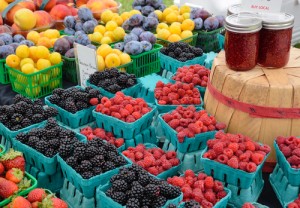“I’d like to eat healthy food, but those stores are just too expensive.”
I hear that over and over again, and it’s true. Some of those stores that boast of delicious, abundant produce, grass-fed beef and fresh-caught fish, are indeed expensive, but you do have some other options.
Certainly the solution is not to turn to junk food, which may not cost much now, but what about the later costs of diabetes, obesity, prescription medications, doctors’ bills? When you consider how expensive these could be, eating wholesome food might seem pretty cheap.
Here are 10 easy ways you can keep yourself and the planet healthy without having an empty wallet:
1. Put a cap on bottled water. Americans will buy about 25 billion single-serving bottles of water this year. Producing all those bottles requires more than 17 million barrels of oil every year. Worse yet, nearly 80 percent of those bottles will end up in a landfill. And according to the Natural Resources Defense Council, 40 percent of bottled water is nothing more than tap water anyway. Tap water is more highly regulated than bottled water, and it’s free.
2. Buy in bulk. You can buy in bulk for beans and legumes, grains and breakfast cereals, nuts and seeds, dried fruits, flour, baking ingredients and all sorts of other foods, and it will save you a whole lot of money. Whenever possible, purchase as many as you can of the items on your list in bulk form. A cautionary note: don’t buy more than you will use!
3. Avoid packaged foods. This goes along with the previous tip: by buying large quantities rather than individual items, you will reduce the amount of unnecessary packaging involved. So you can save the planet and eat healthy! Not to mention, packaged goods are generally marked up quite a bit.
4. Buy locally produced food. This works in a couple of great ways: when you do this, you are helping reduce the pollution and depletion of resources associated with the transportation of food. On average, domestically grown produce has traveled some 1,500 miles from farm to table. Locally grown fruits and vegetables are typically picked at their peak; they are cheaper, better for you and more delicious!
5. Grow your own. This is especially cost-effective with fresh herbs, which are easy to grow on the kitchen counter. Even if you live in an apartment the size of a salad bowl, all you need is one sunny window and window box planters or pots at least 8 inches deep with holes for drainage. Radishes, mesclun mix and baby carrots all make a good start.
6. Go organic. Yes, I know, organic actually can be more expensive. But we know that the less exposure to pesticides, hormones and additives the better, so what to do? One solution is to save money by prioritizing produce that contains the most pesticides: peaches, apples, bell peppers, celery, nectarines, cherries, lettuce, imported grapes, pears, spinach and potatoes.
7. Learn your labels. Make sure you really are buying organic food. The label “100% USDA Organic Certified Foods” tells consumers that the organic foods they are purchasing have been produced in accordance with standards set by the US Department of Agriculture. Only food labeled “100% Organic” is totally organic.
8. Shop the farmer’s market. This is a great place to find local fruits and veggies as well as other locally produced goods, like honey and dairy items. And of course buying directly from the farmer cuts out the middle man. If you want to save even more money, try showing up when the market is closing. The selection won’t be as good, but you’ll be able to strike a great bargain with farmers looking to clean out their goods.
9. Make your own. Even if you need food in a hurry, making it at home will almost always be cheaper and healthier than eating out. How long can it take to assemble a peanut butter and jelly sandwich with celery and carrot sticks on the side, or to pull out some salad ingredients and toss them together? And you’ll know exactly what’s in your food – no secret additives for you!
10. Reduce food waste. Get in the habit of serving smaller portions, and tell your kids, partner and best buddies, that they can come back for more if they are still hungry. This will help you cut down on the amount of food you throw out and save money by shrinking your grocery bills, not to mention your waistline! Everybody wins!
With all this in mind, be sure to keep it interesting. The more boring your daily diet is, the more likely you will slip away into unhealthy, expensive eating habits!


The views and opinions expressed in this post are those of the author(s) and do not necessarily reflect those of MomsRising.org.
MomsRising.org strongly encourages our readers to post comments in response to blog posts. We value diversity of opinions and perspectives. Our goals for this space are to be educational, thought-provoking, and respectful. So we actively moderate comments and we reserve the right to edit or remove comments that undermine these goals. Thanks!